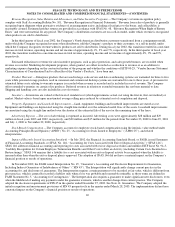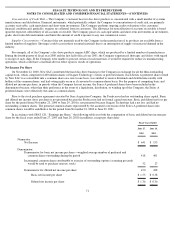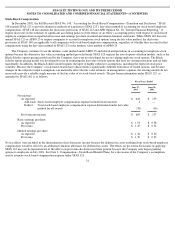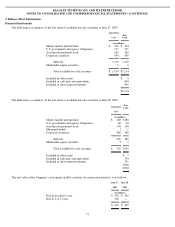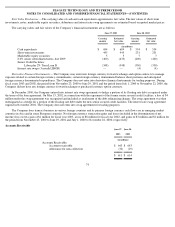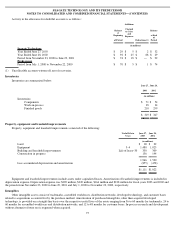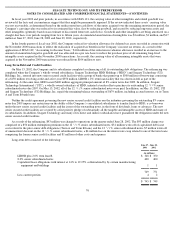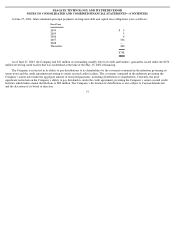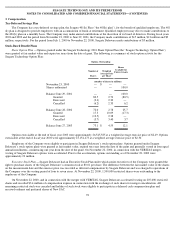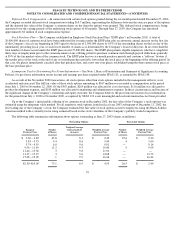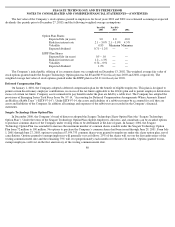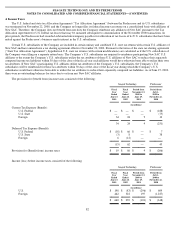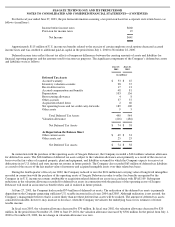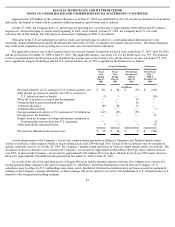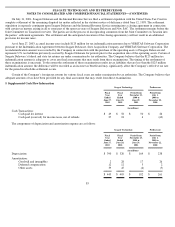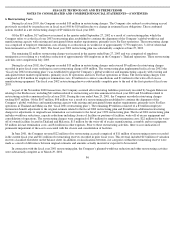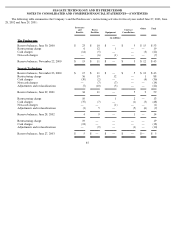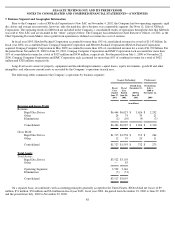Seagate 2002 Annual Report Download - page 85
Download and view the complete annual report
Please find page 85 of the 2002 Seagate annual report below. You can navigate through the pages in the report by either clicking on the pages listed below, or by using the keyword search tool below to find specific information within the annual report.
SEAGATE TECHNOLOGY AND ITS PREDECESSOR
NOTES TO CONSOLIDATED AND COMBINED FINANCIAL STATEMENTS—(CONTINUED)
Deferred Stock Compensation —In connection with certain stock options granted during the six-month period ended December 27, 2002,
the Company recorded deferred stock compensation totaling $10.7 million, representing the difference between the exercise price of the options
and the deemed fair value of the Company’s common shares on the dates the options were granted. This deferred stock compensation is being
amortized over the vesting periods of the underlying stock options of 48 months. Through June 27, 2003, the Company has amortized
approximately $2 million of such compensation expense.
Stock Purchase Plan —The Company established an Employee Stock Purchase Plan (“ESPP plan”) in December 2002. A total of
20,000,000 shares of common stock have been authorized for issuance under the ESPP plan, plus an automatic annual increase on the first day
of the Company’s fiscal year beginning in 2003 equal to the lesser of 2,500,000 shares or 0.5% of the outstanding shares on the last day of the
immediately preceding fiscal year, or such lesser number of shares as is determined by the Company’s board of directors. In no event shall the
total number of shares issued under the ESPP plan exceed 75,000,000 shares. The ESPP plan permits eligible employees who have completed
thirty days of employment prior to the commencement of any offering period to purchase common stock through payroll deductions generally
at 85% of the fair market value of the common stock. The ESPP plan has two six-month purchase periods and contains a “rollover” feature if
the market price of the stock at the end of any six-
month purchase period is lower than the stock price at the beginning of the offering period. In
that case, the plan is immediately canceled after that purchase date, and a new one-year plan is established using the then-current stock price as
the base purchase price.
Assumptions Used in Determining Pro Forma Information —See Note 1, Basis of Presentation and Summary of Significant Accounting
Policies, for pro forma information on net income and earnings per share required under SFAS 123, as amended by SFAS 148.
As a result of the November 2000 transactions, all stock options other than stock options included in the management rollover, were
accelerated and exercised. The full fair value of these stock options amounting to $567 million was recorded as compensation in the period
from July 1, 2000 to November 22, 2000. Of the $567 million, $265 million was allocated to cost of revenue, $116 million was allocated to
product development expense, and $185 million was allocated to marketing and administrative expense. In these circumstances and because of
the significant change in the Company’s ownership and equity structure, the Company believes the pro forma net income (loss) information,
for the period from July 1, 2000 to November 2000, as required by SFAS 123 is not meaningful and such information has not been provided.
Up to the Company’s initial public offering of its common stock in December 2002, the fair value of the Company’s stock options was
estimated using the minimum value method. For all employee stock options issued in fiscal year 2003 subsequent to December 11, 2002, the
first trading day of the Company’s stock, the Company estimated the fair value of stock options issued to employees using the Black-Scholes
valuation method with a volatility factor using estimated based on the stock volatilities of the Company’s publicly traded competitors.
The following table summarizes information about options outstanding at June 27, 2003 (shares in millions).
79
Outstanding Options
Exercisable Options
Range of
Exercise Prices
Number
of Shares
Weighted Average
Contractual Life
(in years)
Weighted Average
Exercise Price
Number
of Shares
Weighted Average
Exercise Price
$ 2.30
–
3.82
45.8
8.1
$
2.30
25.6
$
2.30
3.83
–
5.73
9.4
8.6
5.00
.4
5.00
5.74
–
9.55
6.0
9.6
9.01
—
9.14
9.56
–
11.45
11.2
9.5
10.44
.5
9.99
11.46
–
13.36
.3
9.8
11.94
—
—
13.37
–
15.27
.3
9.6
14.08
—
13.73
15.28
–
19.09
.1
9.9
16.36
—
16.44
$2.30
–
$
19.09
73.1
8.5
$
4.55
26.5
$
2.49


